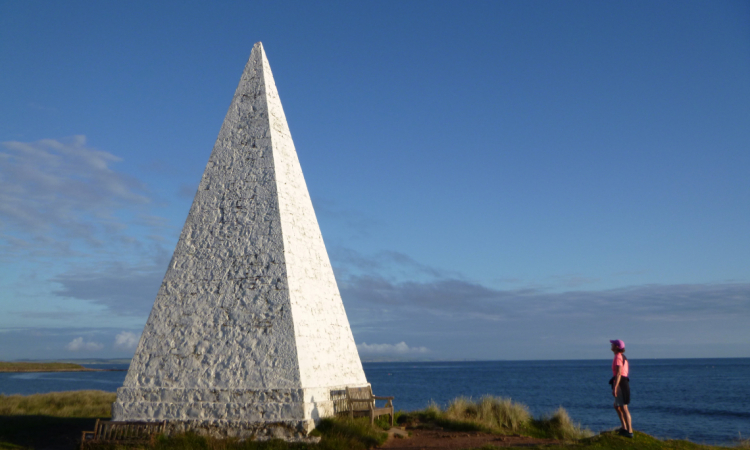Halfway across the sands, with the sea racing in, we broke into a jog. A wooden platform raised on high poles offered sanctuary, but it looked an uncomfortable spot to spend six hours waiting for the tide to retreat. So, we hurriedly sloshed on through pools of slippery seaweed and ankle-deep mud. Besides, we were on the trail of St Cuthbert, not King Canute.
With poor timing, the wife and I arrived in the UK at the same time as Covid-19, spending the next three months locked down at relatives. As restrictions gradually eased, we took the opportunity to explore some of the lesser-known parts of the country, at least to us.
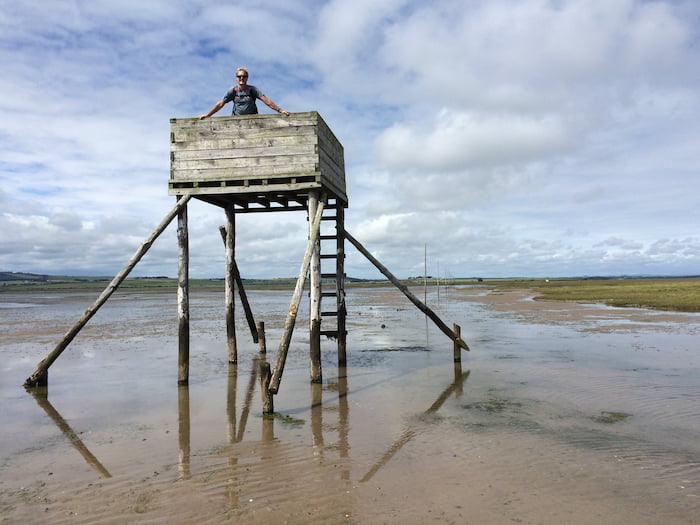
Running for 100km through the Scottish Borders and Northumberland, St Cuthbert’s Way links formative places in the life of this seventh century saint, known as ‘the Wonder Worker of Britain.’ First, we visited Old Melrose, hunting for traces of the ancient monastery which the 16-year-old Cuthbert entered in 651, inspired by a vision from God. By his mid-thirties, he’d become the Prior at Melrose, having survived the Great Yellow Plague - which raged for two decades and did for half of Europe, including his boss. Unfortunately, however, we couldn’t find any monastic ruins; just a cafe which, like most things in Scotland, was closed citing Covid.
The hiking trail officially began at the more modern ruins of Melrose Abbey, built in the 12th century and regularly sacked in the periodic border wars between Scotland and England. Somewhere in its grounds is buried the heart of Robert the Bruce, who defeated the English at Bannockburn in 1314 to secure Scotland’s independence for over three centuries. The wife, being a proud Scot, was keen to pay homage, but the abbey was closed and she had to be content peering over the fence.
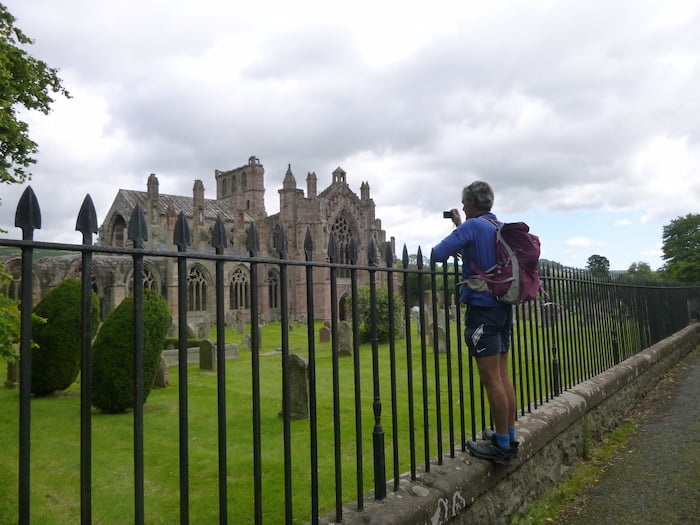
From Melrose, we set out for the Eildon Hills, a trio of pert 400m-high cones, which are supposedly home to King Arthur and his knights. We couldn’t find him either, but from the trig point atop the middle peak we did see the River Tweed meandering through this rolling green landscape that’s staged so many massacres, battles and sackings. There's a heap of history in these borderlands and St Cuthbert is just part of this trail.
Dropping off the Eildons, we detoured across the Tweed to visit the romantic ruins of Dryburgh Abbey and – at the wife’s insistence - a nine-metre-high sandstone statue of the fearsome 13th century Scottish freedom fighter, William Wallace, who skinned an English commander to make a sheath for his sword, before being hung, drawn and quartered. Fittingly, we departed the statue to drum rolls of thunder.
Desperate to escape lockdown’s fetters, we hadn’t bothered with details like the weather forecast, but now started giving this matter more thought. When the storm broke, we sheltered in the Temple of Muses down on the riverbank, huddled awkwardly among four naked bronze women in a small stone gazebo. Being the first on the trail since lockdown, we found much of the path had been consumed by waist-high grass and many way-markers had been swallowed by gorse. Accordingly, we regularly wandered in circles and sometimes entirely off the map.

The final stretch on our first day followed an old Roman road running like a ruler across Ancrum Moor, scene of yet another biffing match between the Auld Enemies in 1545. Covered in wet thistles and shaped like a coffin, we uncovered a memorial to a feisty participant. To quote: ‘Fair Maiden Lilliard lies under this stane; Little was her stature, but muckle was her fame; Upon the English loons she made many thumps; And when her legs were cuttit off, she fought upon her stumps.’ My wife nodded appreciatively.
Logistics were complicated by the fact that, while the hospitality sector in England had re-opened, Scotland was still firmly locked down. So, come late afternoon and still inside Scotland, we nipped over the border by taxi to find lodgings, before returning the next morning to resume.
More by Matthew

The second day progressed through wood, farm and moor lands. Early landmarks included Cessford Castle, now derelict and bursting with vegetation; and Morebattle, where a medieval dragon-slayer dispatched the dreaded Linton Worm. The weather was dramatically moody, with black clouds racing across the cobalt sky, and shafts of brilliant sunlight turning the wheatfields into golden seas. We stomped up Wideopen Hill, the official halfway and high point on our journey. From here, the green and dun ridges of the Cheviot Hills lay ahead, though if we cared to look back, we could still see the Eildons.
After a knee-crunching descent to the Bowmont River, we followed the valley floor into Kirk Yetholm, the last town inside Scotland and historic capital of Scottish gypsies since the late 17th century. The first gypsy king to be crowned here, Patrick Faa, was subsequently deported to America for theft, while his three sons were hanged, and his wife drowned by an angry mob. Meanwhile, at the last recorded ceremony in 1898, Charles Faa Blythe was crowned before a crowd of 10,000, with a whisky bottle broken over his head. Sadly, there have been no subsequent coronations - though former US President Bill Clinton is a descendant – and the gypsy palace it now a self-catering cottage.
Just beyond Kirk Yetholm, we crossed the frontier into England. There were no great formalities; we just squeezed through a gate in a waist-high stone wall. Though the scenery on the other side looked much the same, the Eildon Hills had finally slipped out of sight and, most importantly, pubs and accommodation were open.
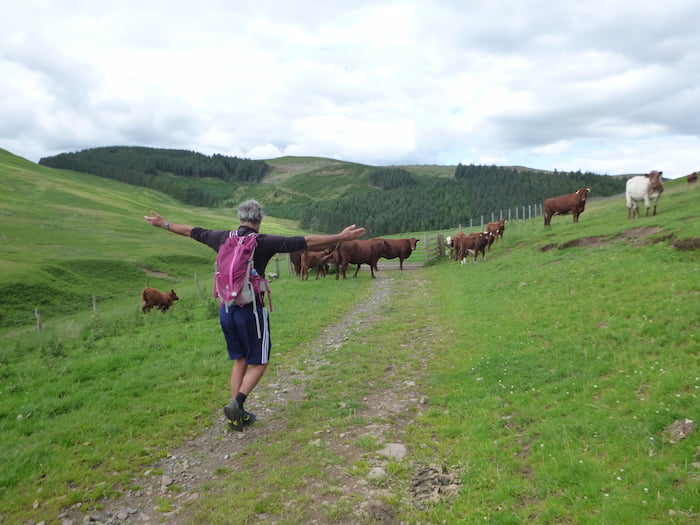
On the third day, we reconnected with St Cuthbert. After tramping up and over Weetwood Moor, we passed through various Hortons, Hettons and Hazelriggs - miniscule communities with zero amenities. The only sustenance was offered by a wooden statue of Cuthbert, holding out a crucifix as if to fend off vampires and with an otter at his feet. According to his earliest biographer, the Venerable Bede in 720, Cuthbert would pray on the beach while otters warmed his toes and – well ahead of his time – he introduced a law prohibiting eider ducks from being eaten.
Just a bit further on, in a wood on Doddington Moor, we found a large sandstone overhang, which was just over head high and the size of a tennis court. According to blurry legends, Cuthbert inhabited this cave as a meditating hermit and some of his followers hid here 200 years later, while escaping marauding Vikings and carrying his miraculously preserved remains. Whatever the truth, it’s a place where you sense stuff happened.
From the cave, we climbed up Greensheen Hill, which provided our first view of the North Sea, with a distant smudge marking our final destination, Lindisfarne. To get there, however, we faced three perilous crossings. The first was the A1 highway and while there weren’t too many cars, they came through fast and we weren’t used to traffic. The next challenge was the east coast high-speed railway, with a dedicated yellow phone booth from which to dial the signalman. ‘How quick are you?’ he asked. ‘We’re not Olympic sprinters, but I think we’ll make it,’ replied my bemused wife, surveying the two-metre-wide cutting. Duly authorised to proceed, we stepped across the tracks, heads swivelling like tennis spectators. A couple of minutes later, down by the shore, we heard the scream of the London-Edinburgh Express.
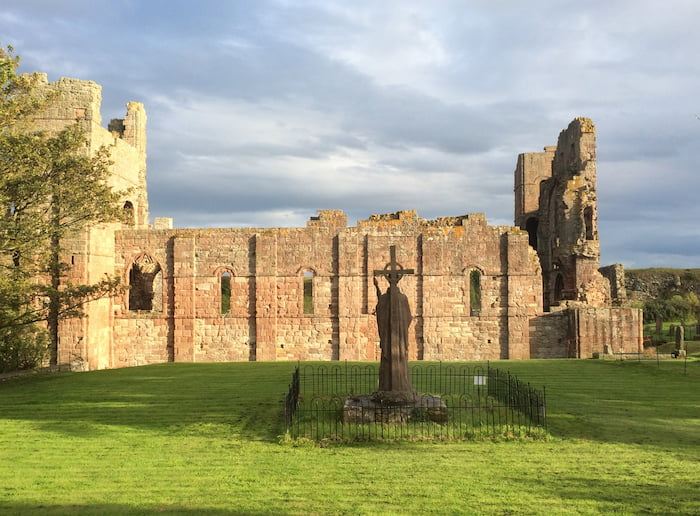
The final, most challenging crossing was over to Holy Island, which is cut off from the mainland at high tide. Though there’s a 2km concrete road causeway, any self-respecting pilgrim rather takes the 4km trail across the sands, marked by wooden poles, with occasional crow’s nests offering emergency shelters. Away on our left, we watched with concern as cars raced across the causeway, heralding the incoming tide – which claims some dozen vehicles each year. Though we thought we had ample time, the soft sand proved slow going and it was a relief to step onto terra firma.
Steeped in history and ambience, tiny Holy Island – aka Lindisfarne – provided a magical conclusion to our journey. It was intimate and atmospheric, especially when the day-trippers departed, leaving just the hundred or so residents, who proudly call themselves ‘Islanders.’ We spent a couple of nights here, in a hotel overlooking the ruined priory. The original seventh century monastery was established by St Aiden, who came over as a missionary from Ireland and also brought the recipe for mead – a heady alcoholic beverage made from fermented honey - though his success converting Northumbria to Christianity was surely coincidental. I suspiciously tasted some of the current brew, Lindisfarne Mead, without being converted. Meanwhile, within the priory grounds, we found a phantasmic-looking bronze statue of Cuthbert – who moved here from Melrose in 665 and - after various sabbaticals – was promoted to bishop.

Each morning at dawn, we hiked around the island, passing the small 16th century Disneyesque castle, from which I half-expected a princess to throw down her locks. From the pyramidal navigation beacon at Emmanuel Head, we could see the now-uninhabited Inner Farne Island, where Cuthbert retired to a small cell in 686 and died the following year, aged 53 - after what the Venerable Bede described as ‘a painful illness’. Then, following a bracing swim in Coves Haven, we would head back for breakfast, our socks thick with alien pirri-pirri burrs, which still haven’t come out.
After a couple of days on Holy Island, we reluctantly steeled ourselves to return to the mainland. But it had been a refreshing and apposite journey. Given he'd lived through a great plague and regional conflicts, while fighting to protect the environment, Cuthbert seemed a man for our times – though I couldn’t help thinking he might have been disappointed with our progress in the intervening millennia.
Shop for a cause
Shop on amazon.com | amazon.co.uk

